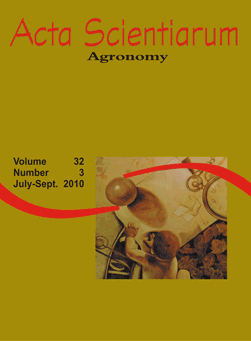<b>Hilling and soil covering in bunching onion yield with two harvests</b> - doi: 10.4025/actasciagron.v32i3.4379
Keywords:
Allium fistulosum, organic residue, culture treatment, gross income
Abstract
‘Todo Ano’ bunching onion was studied and cultivated in soil without and with covering of semi-decomposed chicken manure in doses of 0 and 10 t ha-1 with 0, 1 and 2 hillings, with two harvest dates. The treatments were arranged in a 2 x 3 factorial scheme, in an experimental randomized blocks design, with five replications. Plants were harvested 64 days after planting and 40 days after the last cut (104 days after planting). The tallest (38.1 cm) and the shortest (27.2 cm) plant heights were obtained using treatments with and without covering of chicken manure and one hilling, respectively. The widest diameter of the tiller neck was 5.92 mm at 64 days after planting in with chicken manure treatments and without hilling and the smallest was 4.56 mm at 104 days after planting, in without chicken manure treatment with one hilling. The greatest yield of fresh mass was on the second harvest, in relation to the first, regardless of the studied factors. The best total income was with chicken manure treatment and with two hillings (R$ 23,511.00) because it induced a gain of R$ 2,611.00 in relation to those with one hilling, which was the worst in with chicken manure treatments, and of R$ 13,619.00 in relation to without chicken manure treatment and without hillings which induced the greatest gain in without chicken manure treatments.Downloads
Download data is not yet available.
Published
2010-08-25
How to Cite
Zárate, N. A. H., Matte, L. C., Vieira, M. do C., Graciano, J. D., Heid, D. M., & Helmich, M. (2010). <b>Hilling and soil covering in bunching onion yield with two harvests</b> - doi: 10.4025/actasciagron.v32i3.4379. Acta Scientiarum. Agronomy, 32(3), 449-454. https://doi.org/10.4025/actasciagron.v32i3.4379
Issue
Section
Crop Production
DECLARATION OF ORIGINALITY AND COPYRIGHTS
I Declare that current article is original and has not been submitted for publication, in part or in whole, to any other national or international journal.
The copyrights belong exclusively to the authors. Published content is licensed under Creative Commons Attribution 4.0 (CC BY 4.0) guidelines, which allows sharing (copy and distribution of the material in any medium or format) and adaptation (remix, transform, and build upon the material) for any purpose, even commercially, under the terms of attribution.
2.0
2019CiteScore
60th percentile
Powered by 

2.0
2019CiteScore
60th percentile
Powered by 



















































